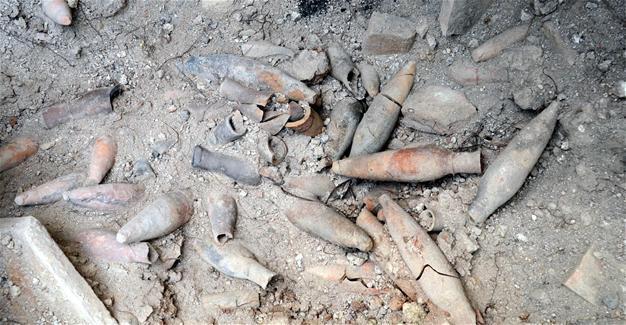Ancient antidepressants found in excavations in Istanbul
ISTANBUL – Doğan News Agency

DHA Photo
Excavations that have been conducted on Bathonea on the coasts of Küçükçekmece Lake in Istanbul’s Avcılar district have unearthed nearly 700 small ceramic or glass bottles containing antidepressant pills and heart disease drugs.“There were lots of pestles, mortars and a big cooker around these bottles. It seems that there was a drug production center here. We also found lots of medical tools and spatulas,” said Associate Professor Şengül Aydıngün, the head of the Bathonea excavations.
This year’s works found thousands of pieces of ceramics together while mostly focusing on laboratory, storage and analysis works.
“We re-evaluated lots of materials that we unearthed in previous years. We found lots of unguentaria [small bottles] during excavations in 2013 and 2015. We thought that their number was 400 but this year we attached together lots of pieces and saw that the number was nearly 700. This number is really high for an ancient age. This is the highest number of ancient bottles discovered in an archaeological excavation. We delivered most of them to the museum,” she said.
Aydıngün also said the Avar Empire attacked Istanbul 1,390 years ago in 626 AD.
“The interesting part is that there are some plants on this field where we are working in winter. These plants are the core of many drugs. The analysis of remnants in the bottles was made by the Scientific and Technological Research Council of Turkey (TÜBİTAK). They got the formulas of two drugs; Methanone and Phenanthrene. One of them is an antidepressant and the other is used in cases of heart diseases. The cores of these drugs were obtained from nearby plants. This is a very good result for us,” she said.
Aydıngün said they discovered a large fire layer in the Bathonea excavation field and that the carbon tests of the fire layers were carried out at the Wroclaw Archaeology and Ethnography Institute in Poland.
“The result of the analysis there may add a new page to Istanbul’s history,” she said. “The fire is estimated to have occurred between 620 AD and 640 AD, which is an important date range. During these dates, there were attacks against Istanbul from Thrace. There was also a serious attack from the Avar Empire in 626 AD. There is a big group of structures in the field of Bathonea. This structure group was almost demolished by the fire. And the bottles remained under this fire layer. This may be evidence of the Avar attack. Historical documents mention this attack, but we have not found archaeological evidence. If it becomes clear, the Bathonea excavations will be the first archaeological evidence for the Avar attacks,” she said.
















